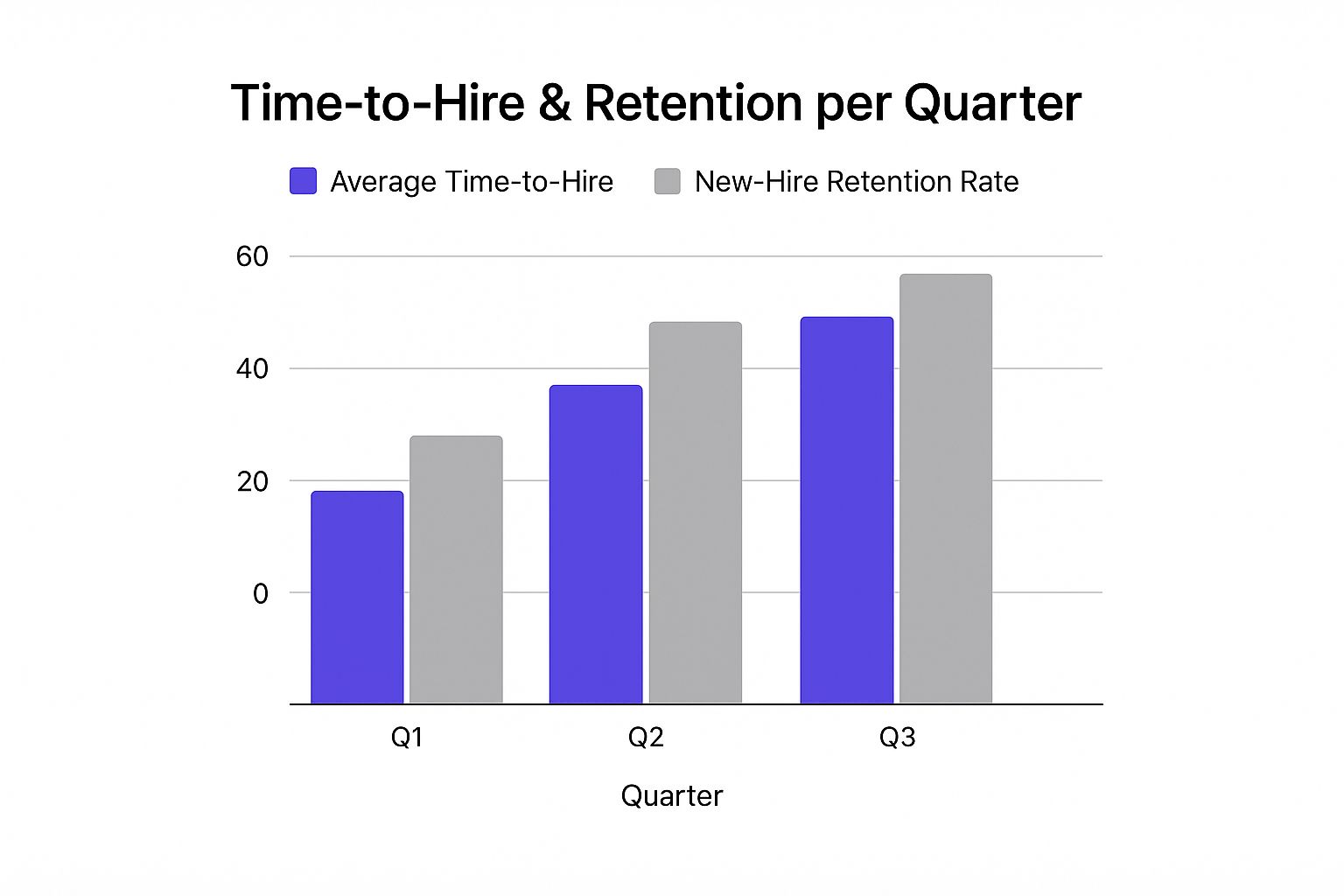If you want to build a truly high-performance team, you have to start with one simple, yet incredibly powerful, idea: psychological safety.
It’s the shared belief that everyone feels safe enough to take risks, voice their concerns, or even admit they made a mistake without getting shut down or humiliated. This foundation of trust is what separates the merely good teams from the truly elite ones.
The Foundation of Every High Performance Team

Before we get into fancy metrics or complex strategies, we have to talk about the one thing a high-performance team absolutely cannot survive without. Psychological safety isn't just a buzzword; it's the bedrock of real innovation, honest feedback, and genuine collaboration. When people feel secure, they bring their A-game.
Think about it this way. You have a junior developer who spots a potential flaw in code written by a senior engineer. In an environment lacking psychological safety, they’ll probably stay quiet. They worry about looking stupid, overstepping, or annoying a senior colleague. That flaw then makes it into production and causes a massive headache for everyone.
Now, imagine that same scenario in a team that has psychological safety. The junior dev speaks up right away. The team talks it through, fixes the bug before it ever becomes a problem, and maybe even thanks the junior for the catch. That's the difference it makes in the real world.
Cultivating a Culture of Trust
Creating this kind of environment doesn't happen by accident. It's an active, ongoing effort, not a one-and-done task. It takes deliberate leadership and consistent reinforcement in how you operate day-to-day. The goal is to build a culture where being vulnerable is a sign of strength, not weakness.
As a leader, you can set the tone by:
- Showing your own vulnerability: Be the first to admit when you don't know something or when you've messed up.
- Framing work as a learning process: Make it clear that hitting roadblocks and learning from setbacks is just part of doing ambitious work.
- Asking for questions: Don't just wait for people to speak up. Actively solicit their input and respond with genuine curiosity, not judgment.
The true test of a team's health isn't how they celebrate success, but how they handle failure. High-performance teams don't just tolerate mistakes; they dissect them, learn from them, and use that knowledge to get better.
This supportive culture has a direct and measurable impact on the bottom line. A huge Gallup analysis of over 183,000 teams found a clear link between engagement (which stems directly from psychological safety) and performance. The most engaged teams were 23% more profitable and saw 18% higher sales than their peers.
Spotting the Warning Signs
On the flip side, you can usually spot a lack of safety if you know what to look for. Keep an eye out for the subtle signs. Are people always quiet in meetings? Does bad news travel slowly, or not at all? Is the first reaction to a problem to find someone to blame?
These are all red flags that trust is broken. Fixing these issues is the first, most critical step on the path to creating a team that can truly excel. For a deeper dive into this, check out our guide on https://www.remotesparks.com/how-to-build-high-performing-teams/.
How To Design Your Team For Success
Great teams don't just happen by accident. They’re built with intention, like a well-designed piece of architecture. The way you structure your team—its size, the people in it, and the skills they bring—lays the groundwork for everything that follows. Get this right, and you're already halfway to building something special.
One of the first, and most important, decisions you'll make is about size. It’s tempting to think that more people means more brainpower, but my experience shows the opposite is usually true. Smaller teams, almost always fewer than 10 people, just work better. They’re faster, more agile, and far more cohesive.
Why? It comes down to basic human dynamics. Once a team gets too big, the lines of communication get tangled. Suddenly, you've got bottlenecks, missed messages, and information getting lost in the shuffle. It also becomes easier for individuals to fade into the background. This is a classic problem called social loafing, where people contribute less because they feel their individual effort won’t be noticed anyway.
The Power of Cognitive Diversity
Numbers are just one part of the puzzle. The mix of people on your team is just as critical. I'm a huge advocate for building teams with cognitive diversity—people who think differently, tackle problems from various angles, and bring unique life experiences to the table.
It’s natural to want to hire people who are just like us. It’s comfortable. But that comfort zone is where innovation goes to die. Homogeneous teams create echo chambers, leading to massive blind spots.
On the other hand, research has shown time and again that diverse teams are smarter and more creative. They challenge each other, poke holes in weak ideas, and ultimately arrive at better solutions. In fact, some studies show they outperform less diverse teams by as much as 12%. This effect is especially powerful in the smaller, more nimble teams we've been talking about.
This infographic breaks down how a thoughtful hiring process, focused on true team fit, impacts things like hiring speed and, more importantly, long-term retention.

As you can see, investing a bit more time upfront to find the right person pays off massively down the road. You get people who stick around, which means less churn and more stability for the entire team.
Assembling The Right Mix Of Skills
When you're putting your team together, don't just look at résumés filled with technical acronyms. The soft skills—communication, empathy, conflict resolution—are what truly hold a high-performing team together. It's worth learning more about identifying critical soft skills during the hiring process so you can build a team that not only works together but thrives together.
A well-designed team isn't just a collection of talented individuals. It's a carefully assembled group where the structure itself makes collaboration feel effortless, not like a chore. The whole becomes truly greater than the sum of its parts.
To illustrate the trade-offs involved in team sizing, consider the following table.
Team Size and Performance Trade-offs
This table illustrates the impact of team size on key performance characteristics, helping leaders make informed decisions when structuring their teams.
| Team Size | Advantages | Potential Disadvantages |
|---|---|---|
| Small (2-5 people) | High agility, clear communication, strong accountability, rapid decision-making. | Limited skill diversity, risk of burnout, key-person dependency. |
| Medium (6-10 people) | Good balance of diversity and agility, shared workload, improved problem-solving capacity. | Communication can start to become complex, potential for subgroups to form. |
| Large (11+ people) | Broad skill set, can handle large-scale projects, more human resources available. | Communication overhead increases exponentially, slower decisions, social loafing is common. |
Ultimately, the goal is to find that "Goldilocks" zone—not too big, not too small—that gives your team the best chance to succeed based on the work they need to do.
So, where do you start? Take a hard look at your current team.
- Skill Mapping: Do you have the right mix of technical chops and people skills to hit your goals? Where are the gaps?
- Diversity Check: Does everyone on your team look, think, and act the same? If so, you have a blind spot.
- Size Assessment: Is your team lean and mean? Or has it gotten bloated and slow?
Being honest about these questions is the first step. Making a few strategic tweaks based on what you find can be all it takes to turn a struggling group into a genuine powerhouse.
Setting Goals That Truly Drive Performance

Let's be honest: vague goals like "improve customer satisfaction" are the enemy of real progress. It sounds good, but it gives your team nothing concrete to grab onto. High-performance teams thrive on extreme clarity. Every single person needs to know exactly what the mission is and, just as importantly, their specific role in getting there.
This kind of clarity turns a simple to-do list into a collective pursuit. It answers the "why" behind the daily grind, making everyone's work feel meaningful. Without it, you get drift. Even your most talented people can end up spinning their wheels, unsure if their efforts are actually moving the needle.
Connecting Team Goals to the Bigger Picture
The best goals are the ones your team can directly connect to the company's grand vision. When people see how their project contributes to the organization's biggest objectives, motivation goes through the roof. It creates a straight line from an individual's daily tasks all the way up to company-wide success.
A great way to build this connection is through goal cascading. You start with the big-picture company goal and work your way down to the individual.
Think of it like this:
- Company Goal: Increase market share by 10% this year.
- Marketing Team Goal: To support that, we need to generate 5,000 new qualified leads in Q3.
- Content Team Goal: Okay, our part is to publish 12 SEO-optimized blog posts and create two new ebooks to capture those leads.
- Individual Goal: My job is to write four of those blog posts each month, focusing on keywords that attract high-intent readers.
See how that works? No one is left wondering if their work actually matters. The connection is right there in black and white. If you want to dive deeper, we have a guide that covers several popular goal-setting frameworks that can give you a solid structure to follow.
A goal without a clear 'why' is just a wish. High performance teams are built on a foundation of shared purpose, where every member understands how their work contributes to the collective mission. This turns accountability from a top-down mandate into a peer-to-peer commitment.
This sense of shared purpose is more critical than ever. A global study found that employees now spend an average of 54% of their work time collaborating in teams. With that much time invested, you have to make sure every minute is focused and aligned.
Break Down Goals into Actionable Steps
Big, hairy, audacious goals are fantastic for inspiration. But they can also be paralyzing. A target like "launch a new product in six months" can feel so massive that no one knows where to even start.
The trick is to chop those huge objectives into smaller, bite-sized milestones. Instead of one giant deadline looming in the distance, you create a series of smaller ones along the way. This approach does two things: it builds momentum and it gives you regular opportunities to celebrate small wins—a huge boost for morale.
Imagine a software team's project broken down like this:
- Month 1: Nail down all user stories and get final sign-off on the UI/UX mockups.
- Month 2: Build the core backend architecture and get all the necessary API endpoints live.
- Month 3: Develop the front-end components and integrate them with the backend.
Each milestone is a concrete, tangible achievement. It proves you're making progress. This not only makes the goal feel less intimidating but also creates natural checkpoints to make sure you're still on track—a true hallmark of teams that consistently deliver.
Mastering Communication and Constructive Feedback
Communication is the absolute lifeblood of any team, but for a high-performance team, it's a whole different ballgame. We're not just talking about status updates. We're talking about fostering a culture of radical candor, where open, honest, and regular feedback is just how things are done.
This becomes non-negotiable for remote and hybrid teams. You don't have those casual office run-ins, so you have to be deliberate about how information flows and how feedback is shared. The goal is simple: make constructive criticism feel like a gift that helps someone grow, not a personal jab.
Creating Robust Feedback Loops
First things first, get rid of the idea that the dreaded annual performance review is your only feedback tool. The best teams run on continuous, real-time feedback that’s both structured and informal.
This means you need multiple avenues for dialogue. A weekly one-on-one is perfect for personal coaching and digging into individual challenges. A project retrospective, on the other hand, lets the entire team reflect on what worked and what didn't. Consistency is everything here. When feedback becomes part of the weekly rhythm, it stops being scary and starts being a powerful tool for getting better.
To really nail this, it's worth exploring strategies on how to improve team communication without just piling on more meetings. It’s all about the quality of the conversation, not the quantity.
Navigating Difficult Conversations
Let’s be honest—giving tough feedback is uncomfortable. But avoiding it is a recipe for disaster and will kill your team's performance. The secret is to frame the conversation around behavior and impact, not personality traits.
For example, instead of saying, "You were sloppy on that report," try this: "When the client report had those formatting errors, it made our team look unprofessional. How about we walk through your proofreading process together to see how we can catch these things next time?"
That simple shift is a game-changer. Why?
- It’s specific. You're pointing to a concrete event, not a vague judgment.
- It’s objective. The focus is squarely on the business impact.
- It’s collaborative. You're opening the door to find a solution together.
In a high-performance culture, feedback isn't personal; it's about a shared commitment to excellence. The conversation shifts from "you did this wrong" to "how can we solve this together?"
Tools and Routines for Remote Alignment
When your team is spread out, you need a smart mix of live (synchronous) and on-your-own-time (asynchronous) communication tools to keep everyone pulling in the same direction. Structured check-ins are absolutely essential for this.
These meetings aren't just for listing off tasks. They're for clearing roadblocks and making sure everyone is focused on the right priorities. To make them count, you have to ask the right questions. If you need some inspiration, our guide on 8 essential check-in meeting questions for 2025 is a fantastic place to start.
Outside of meetings, asynchronous tools are a remote team's best friend. A well-organized project board in a tool like Asana or a dedicated Slack channel for project updates makes information accessible to everyone, no matter their time zone. This kind of transparency builds trust and empowers people to find answers on their own, which is a hallmark of any truly high-performing team.
How to Sustain Momentum and Empower Growth

Getting a team to a high-performance state is a massive achievement. The real trick, though, is keeping that fire lit. The initial excitement and energy will naturally wane unless you actively work to keep it going. For long-term success, your role needs to evolve from director to coach, empowering your people to truly own their work and chase continuous improvement.
Sustaining that drive means trusting your team with genuine responsibility. I'm not just talking about assigning tasks—I mean delegating real ownership. When someone on your team owns a project, they own the decisions, the strategy, and the final outcome. That level of autonomy is one of the most powerful motivators you can offer.
I know this shift can feel like a risk. What if they mess up? The honest answer is: they will. But mistakes are where the real learning happens. Your job is to be the safety net, offering guidance and support when needed, not to jump in and take back the controls at the first sign of a problem. This approach builds a much more resilient and resourceful team.
Foster a Culture of Continuous Learning
Growth can't be a line item in the annual budget or a once-a-year training event. The best teams weave development right into their daily workflow. They see every project as a chance to pick up a new skill or refine an existing one.
Here are a few practical ways to make learning part of your team's DNA:
- Introduce "stretch" assignments. Hand out tasks that are just a little beyond someone's current comfort zone, but be there to provide the support they need to succeed.
- Set up peer-to-peer coaching. You could pair a team member who's a wizard at presentations with someone who wants to get better at public speaking. It's a win-win.
- Host regular knowledge-sharing sessions. These don't have to be formal. A simple 30-minute call where one person demos a new tool they've discovered can be incredibly valuable. We've got more tips on making these engaging in our guide on https://www.remotesparks.com/how-to-run-effective-meetings-tips-for-success/.
When your team is spread out, making these things happen takes a bit more intention. You can find some excellent proven strategies for managing distributed teams that are designed to build a connected culture, no matter where everyone is located.
The moment a team stops learning, it stops being a high-performance team. Empowering growth isn't just a perk for the individual; it's a survival strategy for the team, ensuring you're ready for whatever comes next.
Celebrate Achievements Meaningfully
Finally, never, ever underestimate the power of authentic recognition. People need to know their hard work is noticed and appreciated. But generic praise like "good job" often falls flat and can feel hollow. The secret is to be specific and timely.
Instead of that generic "good job," try something with more substance: "The way you navigated that tricky client negotiation was fantastic. You stayed calm, communicated clearly, and completely turned the situation around. You saved that account." This kind of specific feedback reinforces the exact behaviors you want to see more of and shows you’re actually paying attention.
When it makes sense, make that recognition public. A shout-out in the team meeting or a post in the company-wide Slack channel doesn't just make one person feel good—it shows the entire team what excellence looks like in practice. This creates a positive cycle, inspiring others to aim for that same standard and keeping the team's momentum strong for the long haul.
Answering Your Top Questions About High-Performance Teams
Even with a solid game plan, building a high-performance team can feel like a moving target. Leaders often run into specific roadblocks and need straight answers to tough questions. Let's dig into some of the most common ones I hear.
What's the Single Most Important Factor?
If I had to pick just one thing, it's psychological safety. Hands down. It’s the shared belief that you can speak up with ideas, questions, or even mistakes without fear of being shut down or humiliated.
Think of it as the soil your team grows in. Without it, even the most brilliant people will keep their best ideas to themselves. They won't take risks, challenge the status quo, or admit they need help. Every other component of a great team—clear goals, mutual respect, accountability—thrives when built on this foundation of trust.
Psychological safety isn’t about being “nice” all the time. It’s about creating an environment where talented people feel secure enough to engage in the candid, sometimes tough, conversations that lead to breakthroughs.
How Can I Turn a Struggling Team Around?
When a team is underperforming, the temptation is to blame individuals. That's almost always a mistake. The problem is usually somewhere in the team's system, not a lack of talent.
First, you need to diagnose the real issue. Start by talking to people one-on-one, confidentially. You’ll be amazed at what you learn. Often, you'll find the root causes are things like fuzzy roles, conflicting goals, or just plain bad communication habits.
Once you know what's broken, you can start to fix it. This could mean:
- Creating a team charter together to get everyone on the same page about roles and expectations.
- Setting up new communication routines, like a quick daily stand-up or a more structured weekly sync.
- Facing conflict head-on. Lingering tensions can poison a team. Learning some solid conflict resolution techniques for the workplace gives you the framework to repair relationships and rebuild trust.
How Do You Measure Real Success?
Hitting your quarterly numbers is great, but it's only half the story. A truly high-performance team isn't just productive; it's also healthy and sustainable. You need to look at both sides of the coin.
I recommend tracking a mix of performance data and team health metrics.
- Performance Metrics (The "What"): This is your standard stuff—Key Performance Indicators (KPIs), how quickly projects get done, and the quality of the final output.
- Health Metrics (The "How"): This gets at the team's vibe. Think anonymous team engagement surveys, employee retention rates, and peer feedback on how well everyone is collaborating.
Remember, top performers don't stick around on toxic, dysfunctional teams, no matter how much you're "achieving." If your best people are staying put and feel genuinely engaged, you're not just hitting targets—you're building a culture of excellence that lasts.
Unleash your team's creative potential with Bulby, the AI-powered brainstorming tool designed for remote collaboration. Transform your virtual sessions into dynamic, productive experiences. Start building your next great idea today at https://www.bulby.com.

